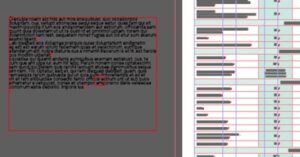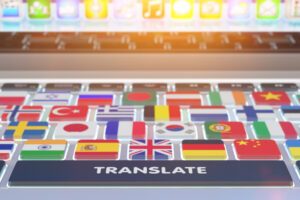Note: This blog post was originally written in Japanese for our Japanese website. We used our machine translation platform Translation Designer to translate it and post-edit the content in English. The original Japanese post can be found here.
Translation agencies like us provide quotes for files in a variety of formats. We constantly pay close attention to the specifications of the requests so as not to include unnecessary text or pages.
In this post, we will share the 4 types of file formats we pay attention to when preparing a quote. If you don't understand about what could be included in the scope, the quote for your file might contain fees for unnecessary sections. To avoid any unnecessary costs and work to be included in your quote, we hope everyone can use this post as a reference before requesting a quote to a translation agency.
This time we will discuss commonly used file formats in an office work setting — Adobe and Microsoft files.
InDesign — handling everything from flyers and posters to catalogs in translation
First, one thing to be careful of with InDesign files is that they may contain text that extends outside the bounds of the page.
In many cases, we ask our customers to enclose a PDF file as a reference, but text outside the page range will not be displayed on the PDF. The original InDesign file often contains draft text or notes from the designers.
Because it is located off the page, as in the images below, there is a risk that it will be overlooked and counted as translatable words when preparing a quote. If such text outside of the page is not part of the work, you should delete it before requesting a quote, so that extra text will not be included in the word count.

Also, images such as .jpg and .png files may be linked in the InDesign file. In this case, the text within the images will not be imported as translatable words when importing the InDesign file into a translation tool.
If the text in the images also need to be translated, it needs to be transcribed in a separate file. In this case, the transcription fees and work process will be added on separately, so you should keep this in mind if there are a lot of images. If you can prepare the text in advance when creating your InDesign document by layering text boxes on top of the images, all of the text will be counted as translatable words without any omissions.
Also, there are many cases where images linked to the InDesign file are not provided with the translation request. When that happens, often times missing images are noticed during DTP (desktop publishing) or layout work, and the first draft of PDF file delivered may have blank areas where images are not present. As a result, the final delivery may be delayed, so it is a good idea to check in advance whether anything is missing.
PDFs — don't think you can easily edit them
Generally, PDF files are not imported into translation tools as is; they are first converted into a Word file and then imported and translated. One thing to be careful of when converting to a Word file is that the text may have line breaks in the middle of a sentence for layout purposes. You would want to fix these line breaks after the conversion so that the whole sentence will be translated properly. When the document consists of many columns or has text placed above an image, line breaks often occur in inappropriate places. These adjustments will become additional costs as to prepare the document before translation work.
Also, the most time-consuming part about working with PDFs is when you have to deal with scanned PDF files. Even if you convert it into a Word file, the text itself will often be recognized as an image, so you will probably have to transcribe all of the text from scratch. Not only is it costly and time-consuming, but transcribing a large amount of text can lead to human errors, which can have a negative impact on translation quality.
Therefore, we encourage everyone to provide the original and not the scanned PDF file if possible.

Word — the first thing to use when it comes to writing
One thing to be careful about in Word files is when they contain comments. Unless we receive instructions, we won't know whether those comments are a target for work or not. Sometimes our customers forget comments are included in the file and are surprised that the amount of content is larger than expected.
On the other hand, we sometimes receive instructions to exclude certain areas from the work by highlighting or other indications. In such cases, a useful feature in Word is to set the text you don't need translation as hidden text. This way, the text will not be recognized as a translation target when imported into translation tools. We recommend this method over highlighting, as it ensures that the original text remains intact.

PowerPoint — your presentation companion
For PowerPoint too, a file may include comments. So, it's a good idea to check the file before sending it to a translation agency.
Also, as is often the case, it would be a good idea to also indicate whether the notes section is to be translated. If you only want the slides translated, you should be careful with the notes section. If you're unaware of it and there happens to be a lot of text in it, it may result in unexpected fees.
Additionally, you need to be careful if you have graphs set up with links. Any text in Excel that has a link set to the PowerPoint will also be imported into translation tools. If you only need to translate the graph legend, it's a good idea to change the link settings or delete any unnecessary text before submitting your document, as all text in the Excel file may be imported.

Summary
As we shared in this post, we take into consideration the file formats that require attention and prepare a quote carefully to ensure that our customers don't have to pay unexpected fees.
If you have the opportunity to work with us in the future, please remember the points shared in this post. Doing so will enable us to carry out projects more accurately and efficiently.
Kawamura's translation services
Kawamura International is certified with ISO 17100, the international standard for translation, and provides translation services based on this standard.
Areas covered include IT and localization, medical devices and pharmaceuticals, tourism, manufacturing, patents, IR and finance, legal affairs, and SAP-related documents. We will assign the most suitable translator to your business and field of expertise. Our translators are experienced, professional translators who have passed our screening standards, so you can rest assured about the quality. Please feel free to contact us with any translation or quote requests.
_CMYK_OL.png)

